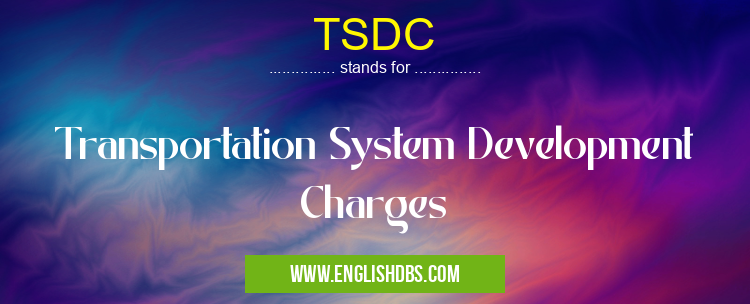What does TSDC mean in TRANSPORTATION
Transportation System Development Charges (TSDC) are fees imposed by local governments on new development projects to fund the construction and maintenance of transportation infrastructure, such as roads, bridges, and public transit. TSDC is a common mechanism used to ensure that new development contributes its fair share towards transportation improvements necessary to accommodate the increased traffic and demand generated by the development.

TSDC meaning in Transportation in Governmental
TSDC mostly used in an acronym Transportation in Category Governmental that means Transportation System Development Charges
Shorthand: TSDC,
Full Form: Transportation System Development Charges
For more information of "Transportation System Development Charges", see the section below.
TSDC Meaning in GOVERNMENTAL
In the context of governmental finance, TSDC is a type of impact fee levied on new development projects to mitigate the negative impacts of the development on the transportation system. It is a specific type of development fee that is dedicated to funding transportation infrastructure projects.
TSDC Full Form
The full form of TSDC is Transportation System Development Charges.
What does TSDC Stand for?
TSDC stands for Transportation System Development Charges, which are fees charged to new development projects to finance transportation infrastructure improvements.
Essential Questions and Answers on Transportation System Development Charges in "GOVERNMENTAL»TRANSPORTATION"
What are Transportation System Development Charges (TSDCs)?
TSDCs are fees imposed on new development projects to help fund the construction and maintenance of transportation infrastructure, such as roads, bridges, and public transit. These charges are typically levied by local governments to ensure that new development pays its fair share of the costs associated with the increased demand for transportation services.
Why are TSDCs necessary?
TSDCs are necessary to address the financial burden that new development places on existing transportation infrastructure. As new developments add residents, businesses, and traffic to an area, the demand for transportation services increases. TSDCs help to offset these costs and ensure that all users of the transportation system contribute fairly to its maintenance and improvement.
How are TSDC rates determined?
TSDC rates are typically established through a comprehensive study that assesses the current and projected transportation needs of the jurisdiction. Factors considered include the type and size of development, traffic impact, and the availability of existing infrastructure. The study also determines the appropriate level of funding required to meet these needs and sets the TSDC rate accordingly.
Who is responsible for paying TSDCs?
TSDCs are typically paid by the developer of a new project. The fees are often assessed as part of the building permit application process and are typically passed on to the end user, such as homeowners or tenants.
How are TSDC funds used?
TSDC funds are used exclusively for the construction, maintenance, and improvement of transportation infrastructure within the jurisdiction. This may include projects such as road widening, intersection improvements, public transit enhancements, and bike paths. TSDC funds cannot be used for general operating expenses or other non-transportation purposes.
Final Words: TSDC plays a vital role in ensuring that new development projects contribute to the improvement and maintenance of transportation infrastructure. By collecting TSDC from developers, local governments can allocate funds specifically for transportation projects and ensure that the transportation system can keep pace with the demands of growing communities. TSDC is a crucial funding mechanism for transportation infrastructure development, helping to create a sustainable and efficient transportation system.
TSDC also stands for: |
|
| All stands for TSDC |
